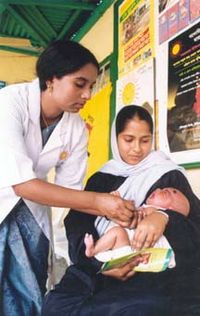
Opportunistic CT screening predicts individuals at risk of major osteoporotic fracture
Sign Up to like & getrecommendations! Published in 2021 at "Osteoporosis International"
DOI: 10.1007/s00198-021-05863-0
Abstract: Millions of CT scans are performed annually and could be also used to opportunistically assess musculoskeletal health; however, it is unknown how well this secondary assessment relates to osteoporotic fracture. This study demonstrates that opportunistic… read more here.
Keywords: fracture; estimated bone; opportunistic screening; abdominal scans ... See more keywords

Opportunistic screening for atrial fibrillation versus detecting symptomatic patients aged 65 years and older: A cluster-controlled clinical trial.
Sign Up to like & getrecommendations! Published in 2017 at "Medicina Clinica"
DOI: 10.1016/j.medcle.2016.07.029
Abstract: Abstract Objective The goal of this study was to assess the effectiveness of opportunistic screening through pulse palpation in the early detection of atrial fibrillation in subjects aged ≥65 years versus detection through an active… read more here.
Keywords: atrial fibrillation; fibrillation; trial; aged years ... See more keywords

Value-added Opportunistic CT Screening: State of the Art.
Sign Up to like & getrecommendations! Published in 2022 at "Radiology"
DOI: 10.1148/radiol.211561
Abstract: Opportunistic CT screening leverages robust imaging data embedded within abdominal and thoracic scans that are generally unrelated to the specific clinical indication and have heretofore gone largely unused. This incidental imaging information may prove beneficial… read more here.
Keywords: added opportunistic; opportunistic screening; body composition; value added ... See more keywords

Opportunistic Screening: Radiology Scientific Expert Panel.
Sign Up to like & getrecommendations! Published in 2023 at "Radiology"
DOI: 10.1148/radiol.222044
Abstract: Radiologic tests often contain rich imaging data not relevant to the clinical indication. Opportunistic screening refers to the practice of systematically leveraging these incidental imaging findings. Although opportunistic screening can apply to imaging modalities such… read more here.
Keywords: radiology; radiology scientific; expert panel; screening radiology ... See more keywords

Establish a Scoring Model for High-Risk Population of Gastric Cancer and Study on the Pattern of Opportunistic Screening
Sign Up to like & getrecommendations! Published in 2020 at "Gastroenterology Research and Practice"
DOI: 10.1155/2020/5609623
Abstract: Objective To investigate and study the related risk factors of gastric cancer (GC) patients, to establish a high-risk scoring model of GC by multiple logistic regression analysis, and to explore the establishment of a GC… read more here.
Keywords: risk; high risk; opportunistic screening; risk population ... See more keywords

Comparison between opportunistic and organised breast cancer mammography screening in the Swiss canton of Fribourg
Sign Up to like & getrecommendations! Published in 2019 at "BMC Cancer"
DOI: 10.1186/s12885-019-5706-1
Abstract: BackgroundBreast cancer screening mammography is widespread in industrialised countries within the framework of public health program or opportunist form. Only few data exist on the comparison of effectiveness between organised and opportunistic screening. The aim… read more here.
Keywords: cancer; opportunistic screening; mammography screening; breast cancer ... See more keywords

The effect of a case-finding app on the detection rate of atrial fibrillation compared with opportunistic screening in primary care patients: protocol for a cluster randomized trial
Sign Up to like & getrecommendations! Published in 2021 at "Trials"
DOI: 10.1186/s13063-021-05497-x
Abstract: Background Atrial fibrillation is a cardiac arrhythmia commonly encountered in a primary care setting. Current screening is limited to pulse palpation and ECG confirmation when an irregular pulse is found. Paroxysmal atrial fibrillation will, however,… read more here.
Keywords: atrial fibrillation; fibrillation; primary care; opportunistic screening ... See more keywords

Do fears of getting cancer and family history of cancer influence participation in opportunistic screening or organized screening for gastric cancer
Sign Up to like & getrecommendations! Published in 2017 at "Journal of Clinical Oncology"
DOI: 10.1200/jco.2017.35.15_suppl.e13045
Abstract: e13045Background: Cancer is the leading cause of death in Korea. Individuals with a family history of cancer might overestimate their personal risk for getting cancer and report high cancer-related worry or concern. Those factors could… read more here.
Keywords: family history; fears getting; history cancer; cancer ... See more keywords

Healthcare worker-based opportunistic screening for familial hypercholesterolemia in a low-resource setting
Sign Up to like & getrecommendations! Published in 2022 at "PLoS ONE"
DOI: 10.1371/journal.pone.0269605
Abstract: Background & objective Heterozygous familial hypercholesterolemia (FHeH) is important risk factor for premature coronary artery disease (CAD). Strategies for its diagnosis and prevalence have not been well studied in India. We performed healthcare worker-based opportunistic… read more here.
Keywords: worker; worker based; based opportunistic; healthcare worker ... See more keywords

The Practice and Willingness of Women Towards Opportunistic Screening for Breast and Cervical Cancers in Sichuan Province, China: A Cross-Sectional Study
Sign Up to like & getrecommendations! Published in 2023 at "Risk Management and Healthcare Policy"
DOI: 10.2147/rmhp.s391534
Abstract: Purpose To understand the practices and willingness of Chinese women to undergo opportunistic screening for breast cancer (BC) and cervical cancer (CC). Patients and Methods From July to August 2021, a cross-sectional study of 1446… read more here.
Keywords: willingness; opportunistic screening; sichuan province; physician recommended ... See more keywords

Opportunistic Screening for Osteoporosis Using CT Scans of the Knee: A Pilot Study.
Sign Up to like & getrecommendations! Published in 2023 at "Studies in health technology and informatics"
DOI: 10.3233/shti230305
Abstract: Knee CT scans are used for planning for total knee arthroplasties in patients who are often simultaneously at risk for frailty fractures due to low bone mineral density. We retrospectively identified 200 patients (85.5% female)… read more here.
Keywords: scans knee; osteoporosis; screening osteoporosis; using scans ... See more keywords